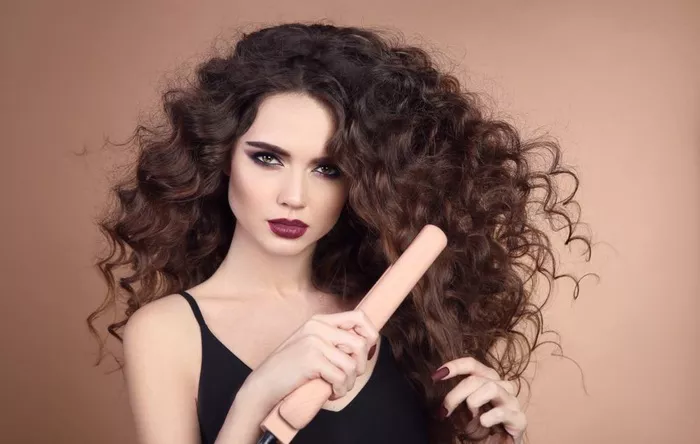Black curly hair, particularly Type 4 textures (4a, 4b, 4c), is a crown of beauty but requires meticulous care when heat styling. Its tightly coiled structure, prone to dryness and breakage, demands a methodical approach to straightening. The challenge lies in temporarily relaxing curls while preserving their natural integrity. This guide focuses on techniques that prioritize hair health, ensuring your curls bounce back to life when you’re ready to embrace them again.
Preparing Your Hair: The Foundation of Success
Start with a Clean, Hydrated Base
Begin by washing hair with a gentle clarifying shampoo to remove product buildup, oils, and pollutants. Buildup acts like a barrier, blocking heat from penetrating evenly and forcing you to use higher temperatures. Follow with a deeply moisturizing conditioner infused with ingredients like shea butter, argan oil, or honey. These components smooth the hair cuticle and add elasticity, reducing the risk of breakage during styling. For hair that feels particularly dry or damaged, apply a pre-shampoo oil treatment (such as coconut or jojoba oil) 30 minutes before washing to lock in moisture.
Detangle with Patience and Precision
Never detangle dry hair—this is a recipe for breakage. While hair is damp, apply a slippery leave-in conditioner or detangling spray. Use a wide-tooth comb or your fingers to gently work through knots, starting from the ends and moving upward. Divide hair into 6–8 sections using clips to maintain control and avoid tangling.
Shield Hair from Heat Damage
Apply a heat protectant spray or serum from roots to ends, focusing on the mid-lengths and ends where heat exposure is most intense. Look for formulas containing silicones like dimethicone or cyclopentasiloxane, which create a protective thermal barrier. Blow-dry hair using a comb attachment on medium heat, stretching each section under tension. This pre-stretching step minimizes the amount of direct heat needed later and creates a smoother base for flat ironing.
Choosing Tools That Protect and Perform
The Right Flat Iron for Your Hair Type
Invest in a high-quality flat iron with adjustable heat settings. Ceramic plates are ideal for fine or color-treated hair, as they distribute heat gently. Titanium plates, which heat up quickly and maintain consistent temperatures, are better suited for coarse, thick textures. Avoid cheap irons with uneven plates—these create hot spots that can fry your hair.
Supporting Tools for Precision
A wide-tooth comb or detangling brush prevents breakage during prep.
Sectioning clips with satin or silicone lining reduce friction and keep hair organized.
A boar bristle brush post-styling helps distribute natural oils for added shine.
The Straightening Process: Step-by-Step
Section Strategically
Divide hair into horizontal layers, starting at the nape of the neck. Smaller sections (1–2 inches wide) ensure even heat distribution and reduce the need for multiple passes. Clip away the upper layers to avoid accidentally reheating previously styled sections.
Set the Correct Temperature
Adjust your flat iron’s temperature based on your hair’s thickness and health:
Fine or color-treated hair: 300–330°F
Medium textures: 340–370°F
Coarse or thick hair: 380–400°F
Always test a small, discreet section first. If the hair sizzles, smells burnt, or feels overly dry, lower the temperature immediately.
Glide with Care
Clamp the iron close to the roots (without touching the scalp) and glide it down the hair shaft in one smooth, steady motion. Avoid going over the same section more than twice. For stubborn coils, pause for 1–2 seconds midway to allow heat to penetrate. When styling edges or baby hairs, use a mini flat iron and wrap strands around the tool in a rolling motion for a polished finish.
Maintaining Straightened Hair: Day-to-Day Care
Protect Your Style Overnight
Sleep on a silk or satin pillowcase to minimize friction and moisture loss. Wrap hair in a silk scarf or bonnet, or tie it into a loose, low ponytail. Avoid tight styles that pull on the roots.
Combat Humidity and Moisture
Humidity is the enemy of straightened hair. Apply a silicone-based anti-frizz serum to create a moisture-repellent barrier. If caught in rain or sweating, blot hair immediately with a microfiber towel and use the flat iron on the lowest heat setting (300°F) to reseal the cuticle.
Refresh Without Overloading Products
Revive roots on day two or three with a lightweight dry shampoo. Smooth flyaways by running a toothbrush sprayed with hairspray over them. For ends, use a tiny amount of water-free moisturizer containing ceramides or jojoba oil—these mimic natural oils without reactivating curls.
Common Mistakes and How to Avoid Them
Skipping Heat Protectant
Direct heat on unprotected hair melts the cuticle, leading to irreversible damage. Heat protectant is non-negotiable—even if you’re short on time.
Overusing High Heat
Fine or damaged hair cannot tolerate high temperatures. Start low and increase gradually only if necessary.
Neglecting Regular Trims
Split ends travel up the hair shaft, ruining straightened styles and causing further damage. Trim every 8–12 weeks to maintain healthy ends.
Alternatives to Heat for Temporary Straightening
Silk Press
A professional silk press combines blow-drying, flat ironing, and deep conditioning for salon-level sleekness. This method minimizes heat damage by using precise tension and moisture-balancing products.
Roller Sets
Wrap stretched, damp hair around magnetic rollers and sit under a hooded dryer. This heat-free technique offers temporary straightening that lasts up to two weeks.
Banding Method
Secure damp hair into low-tension ponytails with soft cloth bands every 2 inches. Air-dry or diffuse to stretch the roots naturally.
Conclusion
Straightening black curly hair can be safe and satisfying when approached with respect for its unique needs. Prioritize moisture, use heat sparingly, and always listen to your hair’s signals. If it feels dry, brittle, or starts shedding excessively, take a break from heat and focus on recovery. Embrace protective styles like braids, twists, or wigs between straightening sessions to maintain your hair’s strength and vitality. Remember, the goal isn’t just straight hair—it’s hair that thrives in all its forms.
Related topics:
How to Style Short Permed Black Hair
12 Ways to Style Short Black Hair, According to Hairstylists


